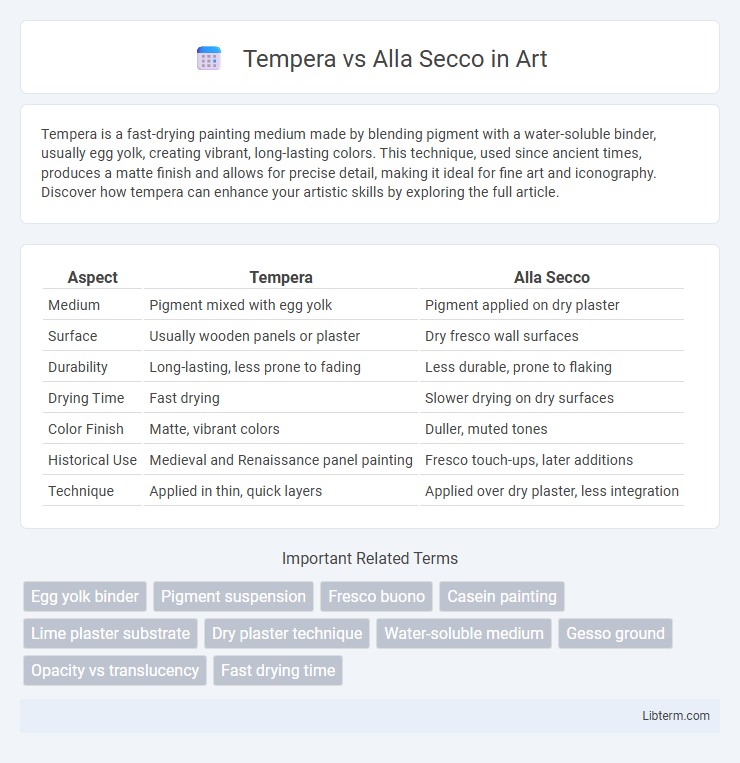Tempera is a fast-drying painting medium made by blending pigment with a water-soluble binder, usually egg yolk, creating vibrant, long-lasting colors. This technique, used since ancient times, produces a matte finish and allows for precise detail, making it ideal for fine art and iconography. Discover how tempera can enhance your artistic skills by exploring the full article.
Table of Comparison
| Aspect | Tempera | Alla Secco |
|---|---|---|
| Medium | Pigment mixed with egg yolk | Pigment applied on dry plaster |
| Surface | Usually wooden panels or plaster | Dry fresco wall surfaces |
| Durability | Long-lasting, less prone to fading | Less durable, prone to flaking |
| Drying Time | Fast drying | Slower drying on dry surfaces |
| Color Finish | Matte, vibrant colors | Duller, muted tones |
| Historical Use | Medieval and Renaissance panel painting | Fresco touch-ups, later additions |
| Technique | Applied in thin, quick layers | Applied over dry plaster, less integration |
Introduction to Tempera and Alla Secco
Tempera is a fast-drying painting medium made from colored pigments mixed with a water-soluble binder, usually egg yolk, renowned for its durability and vibrant colors in early Renaissance art. Alla Secco is a fresco technique where pigments mixed with a binding medium are applied to dry plaster, allowing for detailed finishing touches but less permanence compared to true fresco. Understanding the differences between tempera and alla secco reveals unique applications in historical and contemporary mural painting practices.
Historical Background of Tempera Painting
Tempera painting, dating back to ancient Egyptian and Byzantine art, utilizes egg yolk as a binder, producing vivid, fast-drying colors ideal for detailed and durable artworks. Its historical prominence peaked during the early Renaissance before the widespread adoption of oil painting, marking it as a foundational technique in Western art history. Unlike alla secco, which applies pigment on dry surfaces, tempera's precise layering created distinct textures fundamental to medieval and early Renaissance iconography.
Origins and Evolution of Alla Secco Technique
The Alla Secco technique, originating in ancient Mediterranean fresco painting traditions, evolved as artists sought alternatives to the fast-drying limitations of buon fresco. Unlike tempera, which uses egg yolk as a binder on dry surfaces, alla secco involves applying pigments mixed with binders like casein or glue onto dry plaster, allowing for greater detail and color variation. This method gained prominence during the Renaissance as painters aimed to enhance textures and prolong panel and wall painting durability.
Core Differences: Tempera vs Alla Secco
Tempera painting uses pigment mixed with a water-soluble binder like egg yolk, creating a fast-drying, durable paint ideal for fine detail and layering on rigid surfaces such as wood panels. Alla Secco technique involves applying pigments onto dry plaster walls using a binder like egg tempera, oil, or glue, which results in less durable artwork compared to fresco but allows for more correction and detail after the plaster has dried. Core differences lie in tempera's application on wood supports with rapid drying properties versus alla secco's wall painting method on dry plaster, affecting durability, technique, and restoration potential.
Materials and Tools Required
Tempera painting requires egg yolk as a binder mixed with pigments, a rigid surface like wood panels, and fine brushes to achieve precise detail. Alla secco technique uses dry plaster wall as a substrate, with pigments mixed in water applied after the plaster has dried, necessitating softer brushes and sometimes binding agents like casein or glue for adhesion. Both methods demand specific materials to ensure pigment stability and durability, but tempera relies heavily on organic binders, while alla secco depends on proper plaster preparation and pigment integration.
Application Methods Compared
Tempera painting uses pigments mixed with egg yolk, applied in thin, fast-drying layers that bond well to rigid surfaces like wood panels, allowing precise detail and durability. Alla secco involves applying pigment onto dry plaster, requiring slower, more deliberate brushwork to achieve adhesion, often resulting in a more matte and less durable finish compared to tempera. The key difference lies in tempera's rapid drying and strength on prepared boards versus alla secco's slower application and vulnerability on dry wall surfaces.
Durability and Longevity
Tempera paintings use egg yolk as a binder, creating a durable and long-lasting finish resistant to cracking and fading over centuries. Alla secco technique applies pigments onto dry plaster, making the artwork more susceptible to flaking and deterioration due to moisture and environmental factors. Consequently, tempera offers superior longevity and durability compared to alla secco for preserving fine details and vibrant colors.
Artistic Effects and Visual Results
Tempera produces vibrant, matte finishes with fine detail due to its fast-drying, water-based egg yolk binder, allowing for precise layering and crisp lines. Alla Secco, painted on dry plaster, offers softer edges and more muted, subtle textures by enabling blending and reworking of pigments after application. The rigid, durable surface of tempera contrasts with alla secco's delicate, textural variations, resulting in distinct visual and tactile artistic effects.
Famous Works and Artists
Tempera, known for its vibrant color and durability, was famously used by artists like Sandro Botticelli in "The Birth of Venus" and Giotto in the "Scrovegni Chapel frescoes," showcasing meticulous layering techniques. Alla Secco, a fresco technique applied on dry plaster, is exemplified in works such as Leonardo da Vinci's unfinished "The Last Supper," highlighting its delicate, less durable finish compared to traditional fresco. These methods represent distinct periods and styles in art history, with tempera dominating early Renaissance paintings and alla secco offering detail in larger mural compositions.
Choosing the Right Technique for Your Art
Choosing between tempera and alla secco depends on the desired texture and longevity; tempera offers vibrant, long-lasting colors through egg yolk binders, ideal for fine detail work. Alla secco, painted on dry plaster, allows for flexible, quicker applications with matte finishes but is less durable over time. Artists must consider surface preparation, drying time, and colorfastness to select the optimal technique for their specific artistic goals.
Tempera Infographic

 libterm.com
libterm.com